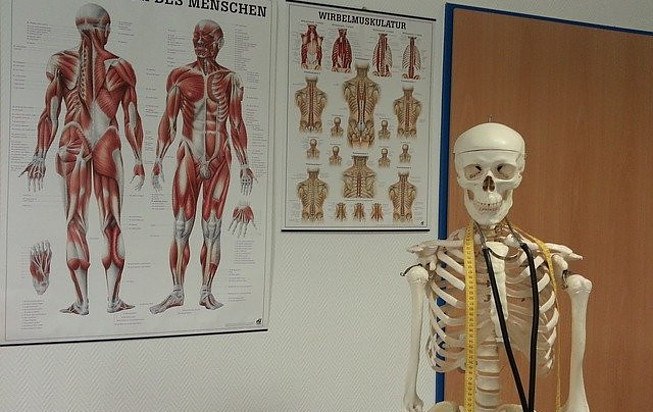Pain is an unpleasant emotional and sensory experience. Most often, pain is classified by the body parts affected by it or the type of injury that causes it. Out of all kinds, muscle pain and bone pain all of us have experienced at some point. Some of us even may deal with either day-to-day.
Differentiating between bone pain and muscle pain can be a difficult task, especially when they have not been personally experienced or if you have not put much attention to them.
Most people think bone pain and muscle pain are similar, but it is not true. They have their differences both in what causes them and their symptoms.
In this article, we are going to explore the difference between muscle pain and bone pain, helping you to identify the pain you or your loved one’s may deal with.
Let’s recap what’s muscle pain is, firstly.
What is Muscle Pain?
Muscle pain, also known as myalgia, is a symptom that comes with a large group of diseases.
Muscle pain is very common. At some point, almost every individual has experienced muscle discomfort.
This pain type can be practically felt anywhere because almost all parts of the body have muscle tissue.
Muscle pain is majorly associated with overuse, tension or muscle injury from hard physical work or exercise.
Most times, the pain affects particular muscles and begins during or immediately after an activity. Often, the activity you engaged in that leads to the pain felt is known.
Again, muscle pain can be a symptom of a disease affecting the whole body. Like some infections and some disorders affecting the connective tissues all over the body can generate muscle pain.
Another cause of muscle pain or aches that is common is fibromyalgia, a disease that causes tenderness in the body and in the surrounding soft tissue, fatigue, headaches and also having some kind of difficulty in sleeping.
Causes of Muscle Pain
There are many causes of muscle pains while some are widespread others are not.
- Trauma or injury, including strains and sprains.
- Overuse, this happens when the muscles are being stressed and overworked.
- Stress or tension.
Other causes of muscle pain include;
- Some drugs, which include ACE inhibitors used for blood pressure control, strain for cholesterol control and cocaine.
- Dermatomyositis.
- Electrolyte imbalance, like very little calcium or potassium in the blood.
- Fibromyalgia.
- Infections, like the flu, malaria, Lyme disease, polio, muscle abscess, trichinosis (roundworms) Rocky Mountain spotted fever.
- Lupus.
- Polymyositis.
- Polymyalgia Rheumatica.
- Rhabdomyolysis.
Tip: If a wound infection causes muscle pain, stick with best wound dressings to heal it fast. Be caution of using hydrogen peroxide. And, we have also provided many tips on getting rid of muscle aches when you are sick.
[et_bloom_locked optin_id=optin_3][/et_bloom_locked]
Are Muscles Pain and Nerve Pain the Same?
Muscle pain and nerve pain may look alike, but when carefully examined, they have their differences.
Tip: Here’s our guide exploring all the differences between muscle pain and nerve pain.
How do Nerve Pains Operate?
Nerves serve as an electrical line that connects the brain to the body, helping both the body and the mind to connect and communicate.
The nerve can become injured or damaged and cease to work as it is meant to just like the electrical wires that can short circuit.
An injured nerve can pass the wrong signal to the brain, for example, the nerve might signal the brain that the hand is hurting even when no activity could prompt the sensation.
How do the Nerve Pains Feel?
Nerve pain ironically is not always described as “painful”. There were different specific descriptions used to describe such feelings or sensations.
They are;
- Burning sensation
- Numbness
- Tingling
- Stabbing sensation
- “Pins and needles”
- Electric shock pains
Causes of Nerve Pain
Many diseases and circumstances can cause nerve pain.
The key are:
- An injury to the spine, brain or nerves.
- Stroke
- Multiple sclerosis
- Too much of alcohol
- Deficiency of vitamin B12 or vitamin B1
- Nerve invasion by tumor or nerve compression
- Some medications
- Diabetes
- Infections like HIV/AIDS and shingles
- Cancer and its treatment with surgery, radiation or chemotherapy
- When the nerve is trapped as in sciatica or carpal tunnel syndrome
Other Conditions that can Cause Nerve Pains
Pressure on the lower back nerves causes pain on the leg, which usually accompanied by needles and pins, weakness or numbness in the leg.
- Fibromyalgia
Chronic pain syndrome is associated with aching or burning pain in various parts of the body. It is not yet clear what causes it, but poor sleep and emotional distress
can trigger it. There may also be genetic factors.
Tip: Here are stress symptoms in men, women and children. They are not the same. Similarly, panic attack symptoms in women, men and children are distinguishable too.
- Peripheral Neuropathy
This is a result of damaged peripheral nerves that links the spinal cord and brain to other parts of the body. It is usually caused by auto-immune diseases, diabetes, and other conditions.
Now, let’s explore about bone pain.
What is Bone Pain?
Bone pain is an intense aching, tenderness or other unease in the bones.
Bone pain is quite different from joint and muscle pain because its an effect that is always constant, whether the bone is functioning or not.
Bone pain is generally categorized as a disease that affects the normal structure or functions of the bone.
What are the Causes of Bone Pain?
Many events or conditions can trigger bone pain.
- Injury
Injuries are one of the major causes of bone pain. Typically, bone pain occurs when a person gets involved in some form of trauma, like a fall or a car accident. The impact may fracture or even break the bone. Any injury to the bone can generate bone pain.
- Metastatic cancer
This type of cancer begins from a particular area in the body and then spread across to other parts. Breast, thyroid, lung, prostate, and kidney cancers are parts of the cancers that are easily spread to the bones and could cause bone pain.
- Mineral deficiency
The bones need a variety of vitamins and minerals, including vitamin D and calcium to stay strong.
A deficiency in vitamins D and calcium always results in osteoporosis, the type of bone disease that is very common. Individuals with osteoporosis late stages experience bone pains.
- Bone cancer
Bone cancer is cancer that is formed majorly in the bone. It can lead to bone pain when cancer tends to destroy or disrupt the normal structure of the bone.
- Infection
When an infection begins in or circulates through to the bones, it can develop into a grave disease known as osteomyelitis. This bone infection is capable of killing the bone cells and generate bone pain.
- Some other diseases
Diseases like sickle cell anemia hinder the supply of blood to the bones. Bone tissue weakens without a constant release of blood. This, as a result, weakens the bone and could significantly increase the pain.

Is Bone Pain and Joint Pain the Same?
Bone pain generally is not as common as joint pain.
Bone pain is always described as a sharp pain mostly, especially when it involves fracture.
Joint pain is usually within the affected joint. Joint pain can be intense and sharp when the cartilage is dead completely or eroded. For example, the back pain due to intervertebral disc/joint prolapse, protrusion or disc bulging. (Most of bulging discs can heal on its own)
Joint pain is most often described as being achy.
Joint pain can go worst with activity, weight-bearing or overuse, depending on the particular joint that is affected.
Tip: Here is the complete list of causes for knee joint pain and natural remedies for knee pain.
How to Determine if it is Muscle or Bone Pain?
Sometimes when there is a pain in the body, it will be challenging to determine why it hurts and the exact place the pain is coming from, whether it is bone pain or muscle pain or entirely something different.
In some cases, trying to distinguish bone pain from muscle pain can be tricky too. Though there may be other possible ways to distinguish either the pain is coming from the bone or the muscle, the sure way to know is through imaging tests (usually ultrasound, CT, MRI or an X-RAY) which can definitively sort out whether the pain is coming from the bone or the muscle.
Monitoring for the following classic signs is the easiest way to distinguish between the two types, though.
[et_bloom_locked optin_id=optin_3][/et_bloom_locked]
What are the Symptoms of Muscle Pain?
- Weakness and stiffness in the area affected.
- Fever is a common symptom of (severe) muscle pain or muscle injury. (But, a bone infection can cause fever too)
- Muscle pain can also be associated with breathing difficulty.
- Swelling and redness could also be symptoms of muscle pain.
- Muscle pain symptoms could also involve rash, bite marks and dizziness.
Tip: Here are home remedies for leg muscle pain.
What are the Symptoms of Bone Pain?
- Cold and fever.
- Sweating mainly at night can be a sign of bone pain.
- Weight loss.
- Fatigue.
Conclusion
Muscle pains are quite normal occasionally, especially when one is new to a sport or active doing exercises. It is therefore advisable to pay attention to the body and stop any activity when you begin to feel pain around the muscles. Also, it is essential to maintain your health, flexible muscles and strong bones as it helps to minimize the risk of incurring bone pains.
Staying away from smoking, moderate drink, enough intake of vitamin D and calcium, as well as mapping out a healthy exercise plan, will help to retain a healthy bone.
Tip: The leading pain-relieving technologies such as Interferential Current (IFC), Transcutaneous Electrical Nerve Stimulation (TENS), Alpha-Stim
and Electrical Muscle Stimulation (EMS) could help with your pains.
Tip: It would be handy to have an Osito Foot Massager or similar massager at home to help with pains too.











0 Comments